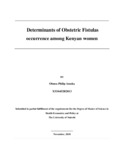Determinants of Obstetric Fistulas occurrence among Kenyan women
Abstract
This study was undertaken to explore the main indicators for obstetric fistula occurrence; a maternal childbirth injury that has been eradicated in developed countries yet it continues to be a debilitating and traumatizing maternal childbirth challenge in parts of Asia and Sub-Sahara Africa including Kenya. Obstetric Fistulas occurrence portray a disconnect between Maternal Health seeking Behavior and utilization (McNamee et al., 2014) of existing medical services, by proxy it’s a representation of unmet maternal healthcare needs and unfinished Post-Millennium Development Global Maternal Health agenda. The 69th World Health Assembly undertook the commitment to implement the Global Strategy for Women, children and Adolescents' Health (2016-2030) which is anchored on the strategy set to ensure that every woman, child and adolescent in any setting, anywhere in the world is able to survive and thrive by 2030. This study investigates the determinants of obstetric fistulas, highlighting its impact with a focus on drawing lessons learnt so as to bridge the gap between adequacy of maternal healthcare services, unmet maternal healthcare needs and the scarce healthcare resources. The Study utilizes the nationally representative Kenya Demographic Health Survey 2014 data on Obstetric Fistulas among Kenyan women. Obstetric fistulas prevalence among Kenyan women directly correlates with Adequacy in maternal healthcare utilization at all levels during pregnancy. Key words: Obstructed labour, Obstetric Fistulas, Healthcare cost burden, Evidence Based Best Practice. Two Stage Residual Inclusion (2SRI).
Publisher
university of nairobi
Subject
Obstetric FistulasRights
Attribution-NonCommercial-NoDerivs 3.0 United StatesUsage Rights
http://creativecommons.org/licenses/by-nc-nd/3.0/us/Collections
The following license files are associated with this item:


